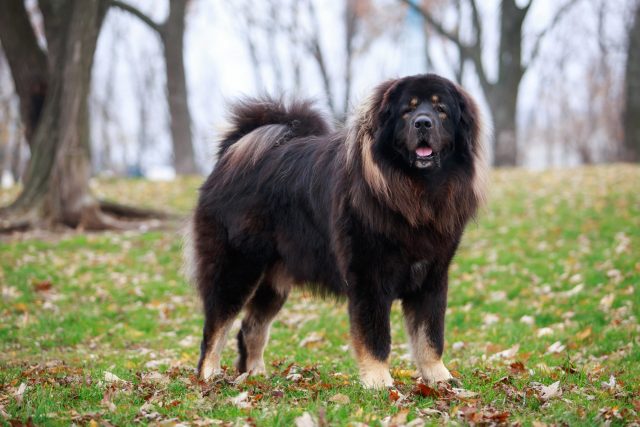Owning a dog is an incredibly rewarding experience that brings joy, friendship, and love into our lives. But it also comes with a lot of responsibility, including financial ones. One of the biggest ongoing expenses is veterinary care, which varies greatly depending on the breed. Certain dog breeds are prone to certain health issues that require frequent veterinary visits, specialized treatments, and sometimes even surgery. Being aware of these potential costs can help future dog owners make an informed decision and prepare for the financial burden. Here, we’ve listed the 16 dog breeds known to be the most expensive for veterinary care, ranked from #16 to #1.
16. Great Dane
Great Danes are gentle giants known for their impressive physique and friendly personalities. However, their large size makes them prone to a variety of health problems that can lead to expensive veterinary care. Common issues include hip dysplasia, heart disease, and gastric dilatation, which are life-threatening conditions that require immediate medical attention. Due to their short lifespan and susceptibility to a variety of health problems, Great Danes can be expensive to own.
15. Bernese Mountain Dog
Bernese Mountain Dogs are loved for their affectionate, gentle natures, but they are prone to a variety of health problems that can result in costly veterinary care. These large dogs often suffer from hip and elbow dysplasia and various cancers, which can lead to costly treatments. Their thick fur also makes them prone to skin problems that require ongoing medical care.

14. French Bulldog
French Bulldogs are hugely popular due to their sweet personalities and compact size. However, their unique physical characteristics can cause a number of health problems. Brachycephalic syndrome, which affects breathing, is common and often requires surgery. They are also prone to hip dysplasia, allergies and spinal disc disease, all of which contribute significantly to veterinary care costs.

13. Newfoundland
Newfoundlands are large, gentle dogs known for their gentle natures and love of water. However, their large size makes them prone to a variety of health problems, including hip and elbow dysplasia, heart disease, and cystinuria, which can lead to the formation of bladder stones. These diseases often require extensive and expensive veterinary treatment, making Newfoundlands one of the most expensive breeds for veterinary care.

12. Rottweiler
Although Rottweilers are sturdy and powerful dogs, they are also prone to a variety of health problems. Hip and elbow dysplasia and heart conditions such as cardiomyopathy are common. Rottweilers are also at risk for a variety of cancers, which can be expensive to treat. Regular testing and treatment for these diseases contributes to the high veterinary costs associated with this breed.

11. English Bulldog
With their wrinkled faces and stocky builds, English Bulldogs are prone to a variety of health problems. Due to their brachycephalic nature, they often suffer from respiratory problems, hip dysplasia, skin infections, and eye problems such as cherry eye. Many of these conditions require surgery and ongoing treatment, resulting in expensive veterinary care.

10. St. Bernard
St. Bernards are large, gentle dogs known for their calm, friendly nature. Their large size makes them prone to a variety of health problems, including hip and elbow dysplasia, heart disease, and an increased risk of certain cancers. Additionally, their thick fur can lead to skin infections and other skin disorders. These health problems often result in expensive veterinary bills over their lifetime.

9. Irish Wolfhound
Irish Wolfhounds are the tallest dog breed and are known for their gentle, friendly nature. However, their large size makes them prone to a variety of health problems, including heart disease, osteosarcoma, and hip dysplasia. Their short lifespan and susceptibility to these serious diseases can lead to expensive veterinary care.

8. Basset Hound
Basset Hounds are easily identifiable by their long ears and droopy faces. Their long bodies and short legs make them prone to a variety of health problems, including hip dysplasia, ear infections and spinal disc disease. Their ears need to be cleaned regularly to prevent infection, and their eyes are prone to diseases such as glaucoma, which can lead to expensive veterinary care.

7. Weimaraner
Weimaraners are beautiful, silver-coated, athletic, and energetic dogs. However, they are prone to a variety of health problems, including hip dysplasia, gastric bloat, and hypothyroidism. They can also develop entropion, a condition in which the eyelids roll inward and become inflamed. These health problems require ongoing medical care and can lead to expensive veterinary care.

6. Doberman Pinscher
Doberman Pinschers are loyal and intelligent dogs, but they are also prone to serious health problems. Dilated cardiomyopathy, which affects the heart, is common in this breed. They are also at risk for hip dysplasia, hypothyroidism, and von Willebrand’s disease, a bleeding disorder. These conditions require regular veterinary care and can be costly.

5. Dachshund
Dachshunds have long bodies and short legs, which makes them prone to spinal disc disease, which can require surgery and lengthy rehabilitation. They are also at risk for obesity, which can exacerbate spinal problems. Regular veterinary visits for spinal health, weight management, and treatment for other conditions such as diabetes can lead to high veterinary bills.

4. Cavalier King Charles Spaniel
Cavalier King Charles Spaniels are small dogs with big hearts, literally and figuratively. They are prone to mitral valve disease, a serious heart condition that requires ongoing treatment. Additionally, they can suffer from syringomyelia, a condition that causes a fluid-filled cavity in the spinal cord. These health problems require regular veterinary visits and treatments that can be costly.

3. Bulldog
Bulldogs, both English and French, are known for their unique physical characteristics and the health problems that come with them. Respiratory problems, hip dysplasia, skin infections, and eye diseases are common due to their brachycephalic breed. Many of these conditions require surgery and ongoing care, resulting in costly veterinary care over the course of their lives.

2. German Shepherd
German Shepherds are intelligent and versatile dogs, but they are also prone to a variety of health problems. Hip and elbow dysplasia are common, as are degenerative myelopathy and a variety of autoimmune diseases. They can also suffer from abdominal bloating, which is a medical emergency. Managing these conditions often requires regular veterinary care and a significant financial investment.

1. Tibetan Mastiff
The Tibetan Mastiff is a little-known, yet incredibly majestic dog. They are known for their impressive physique and thick fur, which makes them prone to a variety of health issues. Common issues include hip dysplasia, hypothyroidism, and entropion. These conditions often require surgery and ongoing treatment. Additionally, the thick fur can cause skin problems that require regular care. The Tibetan Mastiff’s rarity and special care requirements make it one of the most expensive dog breeds to keep in terms of high veterinary costs and medical expenses.

Understanding the likely veterinary costs associated with different dog breeds can help prospective owners make an informed decision. These breeds are known for their health issues, but also bring great joy and friendship. Being prepared for these costs can help owners ensure their dog receives the best care possible, improving their quality of life and strengthening the bond they have with their pet.




